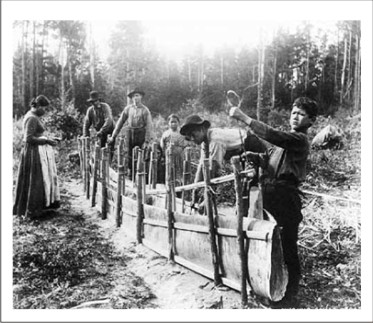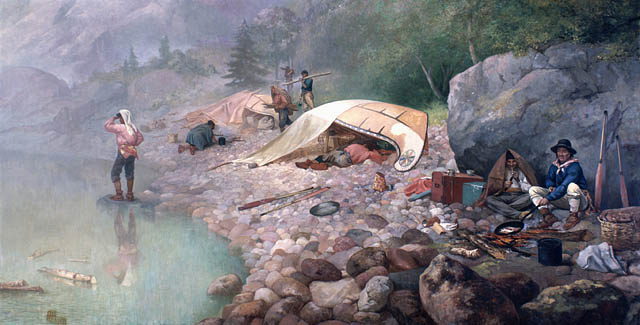The volume writes up a history of Wisconsin (since European settlement), and more specifically, history on the three aforementioned counties. In a unique twist, the "prominent" folk who lived in these counties could pay to have their names and information entered into the volume. I will share some of these accounts in a later post -- a fascinating look at how people wanted themselves to be remembered.
I personally have always wondered why so many things up here, and generally in Wisconsin, are named Nicolet. There is the Nicolet National Forest and Nicolet Area Technical College. Nicolet High School. Nicolet Bank. One might deduce, in etiological fashion, that Nicolet must have been a Frenchman. But who was he?
 | ||
| Nicolet's arrival in Wisconsin: no wonder the natives wanted to throw things |
The first white man to set foot on the soil of Wisconsin was Jean Nicolet, a young Frenchman of Norman birth* who had come to New France, or Canada, in 1618, when both Quebec and Montreal were infant settlements. He was then a very young man of an intrepid and adventurous spirit, and the Governor of New France, Samuel Champlain, saw in him the material for an able lieutenant in the work of advancing French interests in the New World. For that purpose Nicolet was sent to live among the Indians, to learn their language, manners, habits and customs, which he did very satisfactorily, residing among them for a number of years, during which time he suffered many hardships, especially from hunger. With such apprenticeship he was well fitted to become an explorer. About 1632 he returned to Quebec, where for two years he was employed as a clerk and interpreter.*Jean Nicolet de Belleborne was born in Cherbourg, Coutances, Normandie, France in 1598 -- according to Wikipedia. He would have been about 20 when he started his apprenticeship. Check out the Wikipedia page.
Champlain was obsessed with the idea, prevalent at the time, of a short route westward to India and China, and being anxious to discover it, both for the honor and glory of France and his own advancement, sent Nicolet to prepare the way by making peace among the warring Indian tribes, and also instructed him to penetrate as far as possible westward in the hope of discovering the long sought route. Accordingly, in July 1634, furnished with a very imperfect map, Nicolet set out in a canoe from Montreal. He followed the Ottawa River westward, then up a branch of that river and by portage to Lake Nipissing, which he crossed and then went down the French River to Georgian Bay. After stopping there for a while with the Hurons, he proceeded westward along the coast of the bay until he reached the Sault Ste. Marie, the river or waterway connecting Lake Huron with Lake Superior. At the rapids he rested, then, without exploring Lake Superior, which was in part at least depicted on his map, he turned southward, passed through the straits of Mackinac and coasted the northern shore of Lake Michigan until he reached the mouth of the Menominee River, which empties into Green Bay. There from an [Algonquin] tribe he heard about certain "Men of the Sea," who were not far distant, and jumped to the conclusion that he had almost reached China. In order to properly impressed the luxurious Orientals whom he expected to meet, he arrayed himself in a gorgeous robe, with which he had come provided for the express purpose, and pushed his way forward to the head of the bay. He must have been greatly disappointed to meet there only a band of Winnebago [Ho-Chunk] Indians, whose language he could not speak or understand. Making the best of the occasion, however, through his Indian followers he urged them to be at peace with the Hurons and to bring their furs to Montreal to exchange them for the white man's commodities. The occasion was celebrated by a great feast, at which much wild game was consumed.
Nicolet then ascended the Fox River southward to Lake Winnebago and went beyond it to a village of the Mascoutin Indians [a tribe extinct now] which stood probably about where the city of Berlin, Green Lake County, does now. There he first heard of the Mississippi River, but not realizing the importance of the information, and having, besides, fulfilled the main purpose of his mission in making peace between the tribes, he went further southward, visited the Illinois, later returned to the Fox River and Green Bay, and thence to Montreal, which he reached in July 1635, his journey having taken about a year. The discovery of the Mississippi was thus left to others.




